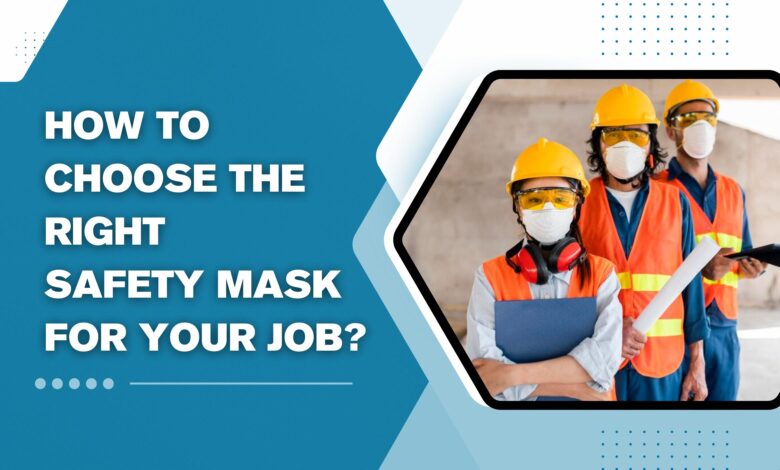How to Choose the Right Safety Mask for Your Job?

Masks, respirators, and industrial face coverings are essential equipment for safeguarding employees in potentially hazardous environments. When combined with physical barriers and social separation, these masks work as a shield to protect you from unknown and unpredictable health hazards. The respirators and full-face masks used in manufacturing environments undergo performance testing following regulatory standards to guarantee the wearer’s safety and the protection of others.
Yet, it can be challenging to understand those rules and choose from the different kinds of protection. Face masks come with diverse functions necessary for different types of workplaces, including the ability to filter dust, guard against smoke, and shield you from potentially dangerous substances. So, let us guide you through the factors to choose the most appropriate protection for your profession.
Significance of Selecting the Right Safety Mask
Wearing the right gear is important, especially for those working in critical situations- your personal protective equipment (PPE) is the only thing standing between you and the danger. The purpose of a disposable dust mask is to provide protection against solid, liquid, and gaseous airborne particles. These particles enter the body through the breathing air and become jumbled up and have the potential to seriously harm your health.
Here’s why selecting the right safety mask is necessary:
- Different masks provide different levels of protection against the airborne particles. Like, a simple cloth mask is suitable to be used in the general public, but an FFP3 mask is necessary to avoid inhaling silica dust at construction sites.
- Inadequate protection can lead to chronic respiratory problems, like asthma, bronchitis, or even long-term lung damage such as chronic obstructive pulmonary disease (COPD).
- A well-fitted mask ensures protection and convenience to the wearer working for long shifts in challenging environments.
- There are different levels of filtration that masks provide, like FFP1, FFP2, and FFP3. Hence, choosing the right one provides precise protection.
A workplace risk assessment can help in finding the right mask that every employee should wear. To identify the proper PPE and training, the Health and Safety Executive (HSE) releases guidelines for performing a risk assessment of your workplace. PPE regulations in the UK align with standards set by British and European bodies, such as the British Standards Institution (BSI) and CE marking requirements, for equipment like respirators and face masks.
Selecting The Appropriate Safety Mask According to Your Profession
There are many different kinds of protective masks to save you from various dangers, but choosing the right mask is necessary. Whether you should stick to a dust masks or invest in a high-quality powered air respirator, here are some things that one should keep in mind:
- Determine the Mask Type
According to European standards, there are three distinct varieties of dust masks: FFP1, FFP2, and FFP3 face masks. Each of these types can offer varying degrees of protection.
FFP1 mask helps guard against non-toxic particles such as plaster of Paris, gypsum, coal dust, sugar, pollen, cement, limestone, and brick dust. It filters nearly eighty percent of the tiny particles in the air, the least in terms of safety masks.
The FFP2 mask successfully filters 94% of the particles and protects the wearer from dangerous mists, fumes, and particulates, including lead dust and fume, softwood dust, granite dust, brake dust, and hay.
FFP3 dust masks offer the best protection available in a disposable mask. The FFP3 masks filter 99% of the particles, protecting the wearers from radioactive dust, germs, viruses, asbestos, and other fine, harmful particles.
Here’s a table that summarizes the efficiency and effectiveness of each respiratory mask:
| Mask | Filtration% | Total Leakage% (maximum) | Usage |
| FFP1 | 80% | 22% | To be used in places with contamination concentration up to 4x the workplace exposure limit |
| FFP2 | 94% | 8% | To be used in places with contamination concentration up to 10x the workplace exposure limit |
| FFP3 | 99% | 2% | To be used in places with contamination concentration up to 20x the workplace exposure limit |
- Consider the Industry
Each mask is unique and works differently for every profession. For example, industrial workers who handle chemicals like solvents, acids, and corrosive substances must wear half-face or full-face respirators with appropriate gas and vapour cartridge filters, compliant with EN 14387 standards.
Whereas if workers inhale welding fumes, they can lead to long-term respiratory issues. In such cases, a powered air-purifying respirator (PAPR) with a particulate and gas filter should be used. You can read the HSE guide to know the specific requirements for using respiratory protection equipment (RPE).
- Check The Fit
When the mask fits snugly around the user’s face and the edge of the mask, there is less chance of leakage. This allows the breathing air to pass through the filter material as much as possible when the user inhales.
Many companies run a fit assessment annually to ensure that workers continue to receive a high degree of security. However, workers wearing tight-fitting respirators, like FFP3 dust masks, should check the seal around the face each time they put it on to ensure the greatest fit.
- Check The Filtration
Filters are used in the mask that blocks airborne contaminants such as dust, fumes, mists, and pathogens. There are different filters for disposable (FFP masks) and reusable masks (half-face and full-face respirators). FFP masks use particulate filters (P1, P2, and P3), classified under the EN 149 standard.
There are different filters, like A, B, E, and K, that are used in combination with particulate filters in the reusable masks. These filters are capable of filtering gases and vapours. For instance, an employee working in an environment with ammonia should use a K-P3 filter as filter K protects against ammonia gas and P3 protects from airborne particles.
Here’s a chart that can help you understand the markings on filters to choose the right filtration:
| Marking | Indication |
| A | Organic gases and vapours with a boiling point greater than 65 degrees Celsius |
| B | Inorganic gases, like chlorine, hydrogen sulphide |
| E | Acid gases, like sulphur dioxide |
| K | Ammonia and amines |
| Hg | Mercury vapours |
| CO | Carbon Monoxide |
| P1 | Particulate efficiency ≥ 80% |
| P2 | Particulate efficiency ≥ 94% |
| P3 | Particulate efficiency ≥ 99% |
| 1 | Filter Class with low capacity for gas/vapour filtration |
| 2 | Filter Class with medium capacity for gas/vapour filtration |
| 3 | Filter Class with high capacity for gas/vapour filtration |
Bottom Line
There are several considerations while buying the most appropriate respirator or safety mask, but in the end, it all boils down to the level of protection needed to do the task at hand. The equipment can help stop the spread of illness and keep you and your team safe while working.
Protective Mask Direct provides a range of face masks to suit your needs, including N95 respirators. Of course, personal protective equipment is not limited to respiratory protection masks. You can find every kind of PPE for all professions at Protective Mask Direct.
Visit us to find out more about how FFP3 disposable dust masks can provide protection at work and how to select the face coverings that will best safeguard your staff.




